Last Updated on January 21, 2024 by Greg Gillson
Are you ready to start feeding wild birds this winter?
Are you looking for new ideas on how to feed your backyard birds?
Do you wonder what birds come to feeders in winter in Missouri?
Welcome!
This article tells why and how to set up a bird feeder in Missouri in the winter. I’ll also show you photos of the common feeder birds in Missouri that you can look for at your own backyard feeder! I will give brief identification tips. I will tell you what foods and what type of feeders attract each species.
Most of Missouri experiences about 110 days of winter temperatures reaching below freezing (October 25 to April 10). It is generally colder in the northwestern part of the state. Winter weather is less severe in the southeastern part of Missouri.
Snow falls mostly in December, January, and February. Again, snowfall is greater in the northwestern parts of the state.
This cold winter weather brings hungry birds to backyard bird feeders. No wonder winter bird feeding is so popular in Missouri!
Why feed winter birds in Missouri?
Missouri is on the Mississippi flyway. Thus, it is on the main route of migratory birds from central Canada in the summer to the Gulf Coast in winter. While especially known for waterfowl and shorebird use, the Mississippi flyway is also a corridor for land birds, too.
Your backyard bird feeder can thus attract a high number of birds, especially in the fall and early winter.
The colder winters of Missouri mean that many hungry birds will visit your feeders. At your feeders they will find the calories they need to keep them warm.
Included will be many younger birds experiencing their first winter. They have instincts to help them find food in winter. But soon they will learn that your bird feeders provided needed food that may help them survive cold spells.
Perhaps, though, more than the survival aspect, attracting birds to our backyard feeders provides us with much needed joy.
Birds at the feeder are a constant source of entertainment. Watching the antics of these wild creatures helps keep our minds off ourselves and whatever problems we may have. It connects us with nature.
Feeding birds just makes us feel better!
What birds come to feeders in winter in Missouri?
Of course, you can feed birds without knowing their names.
But our curiosity soon notes that some birds are at our feeders year round, while others only appear at certain seasons, or very rarely.
I wrote another article on the backyard birds of Missouri found all throughout the year. You should check it out after reading this article. I’ll link to it again at the end of this article.
Ooh, what is that colorful one? What is that one with the distinctive shape or call or behavior?
It may be that you become very interested in more than just your backyard birds. You may travel to shores, forests, fields, and other habitats. You’ll soon find that each habitat has its own unique birds, though there are some birds that are nearly universal in distribution.
But even if that is not you, at least you may want to know the common birds in your area. Then you can share your feeder sightings with your friends and neighbors and family who also may be interested.
Following are the most common winter birds at feeders throughout Missouri. You should have most of these birds at your feeder, and no doubt several others, too!
House Finch
These are one of the most widespread feeder birds in the United States.
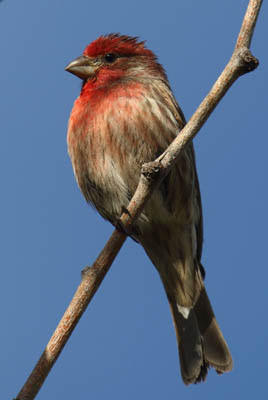 |
| House Finch. Greg Gillson. |
These birds are resident in towns throughout the United States, barely into southern Canada.
House Finches are year-round residents in Missouri.
Both males and females are rather dusty brown, heavily streaked on the chest. Only the males have red feathers on forehead, breast, and rump.
House Finches love to eat black oil sunflower seeds in the shell. They like tube feeders best.
Dark-eyed Junco
These “snow birds” flock to your feeders in winter.
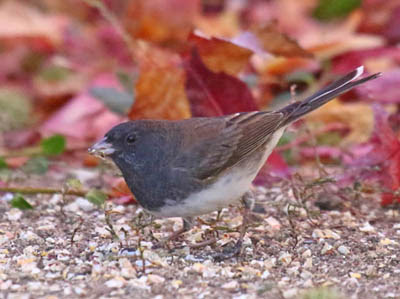 |
| Dark-eyed (Slate-colored) Junco. Greg Gillson. |
Breed in conifer and mixed woods across Canada and Alaska in summer, then migrate into most of the United States in winter. They are also resident in mountains of the West and Northeast.
Dark-eyed Juncos winter throughout Missouri.
The form in the East are small slate-gray birds with white belly and flashing white outer tail feathers. Females are browner. In the West, birds have black heads, brown backs, and pink sides.
Dark-eyed Juncos eat small seeds such as white proso millet on the ground or from low platform feeders.
Blue Jay
These are well-known birds, displayed in advertising and sports teams.
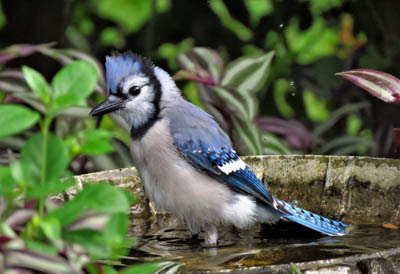 |
| Blue Jay. Skeeze from Pixabay. |
They live year-round in deciduous woods with oaks or nuts through most of the United States east of the Rocky Mountains. In summer they also migrate north well into Canada.
Blue Jays are year-round residents in Missouri.
These are blue above, white below and on the face, with a black necklace across the throat wrapping behind the head. The blue crest is a distinguishing mark.
Blue Jays eat sunflower seeds. They love peanuts, too. They use hopper and platform feeders.
Red-bellied Woodpecker
These woodpeckers are fairly common at bird feeders in the East, especially where there are larger hardwood trees.
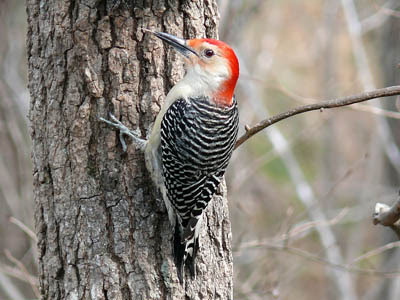 |
| Red-bellied Woodpecker. Skeeze from Pixabay. |
These birds live year-round in the United States east of the Rocky Mountains and Great Plains.
Red-bellied Woodpeckers live year-round throughout Missouri.
These birds cling to tree trunks. They have finely barred black-and-white backs. The head and under parts are rather pale gray. Red feathers on the back of the neck reach the bill on males.
Red-bellied Woodpeckers love peanuts from platform feeders. They also eat sunflower seeds and suet.
Tufted Titmouse
These plain birds are rather common at bird feeders in the East.
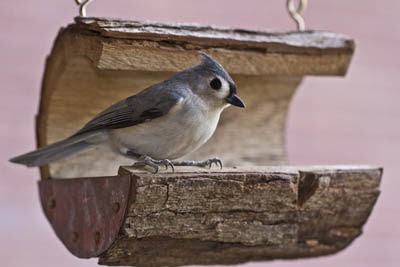 |
| Tufted Titmouse. Anne773 from Pixabay. |
These birds live year-round in deciduous woods east of the Great Plains in the United States.
Tufted Titmouses live year-round in Missouri.
Small, a bit larger than chickadees. They are plain gray with a bit of black feathers on their forehead. The crest is often inconspicuous.
Tufted Titmouses eat black oil sunflower seeds from hopper feeders. They are also fond of peanuts.
Black-capped Chickadee
This bird is a small active acrobatic ball off fluff.
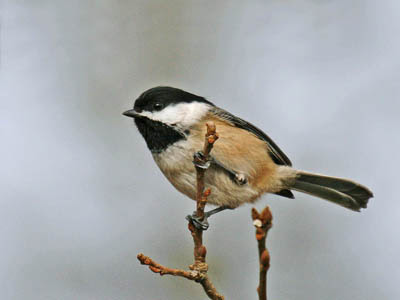 |
| Black-capped Chickadee. Greg Gillson. |
This bird is resident from Alaska and across Canada to the northern half of the United States.
Black-capped Chickadees are year-round residents in the northern half of Missouri.
The white face is bordered by black crown and bib. Upper parts are gray, under parts buff.
Black-capped Chickadees love black oil sunflower seeds from hopper and tube feeders.
American Goldfinch
This bright yellow-and-black bird is a favorite summer bird. However, many people don’t recognize these birds at their feeders in their dull brown winter plumage.
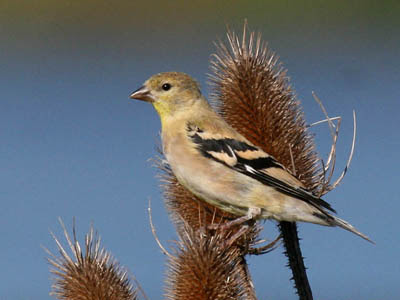 |
| American Goldfinch. Greg Gillson. |
Year-round residents across the northern half of the United States. In summer birds breed north well into Canada. In winter they move south throughout most of the U.S.
American Goldfinches are year-round residents throughout Missouri.
These are tiny birds with short forked black tails. Wings are black. Winter birds are dull brownish. In summer females are green while males are brilliant lemon yellow with black cap.
American Goldfinches eat black oil sunflower seeds from tube feeders. They love Niger seed from thistle feeders.
Mourning Dove
These birds are one of the most widespread in North America.
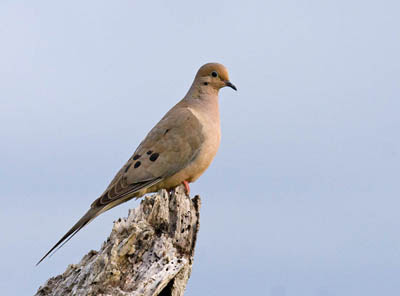 |
| Mourning Dove. Greg Gillson. |
In summer they breed in open fields, farms, prairies, towns, across all of the United States and north into Canada. In winter they depart most of Canada and the northern Great Plains and higher elevations in the northern states.
Mourning Doves are year-round residents throughout Missouri.
These plump birds have a small round head and pointed tail. They are larger than most feeder birds, but not as large as a domestic pigeon.
Mourning Doves eat mixed seeds and grains. They prefer eating on the ground or from platform feeders.
White-throated Sparrow
These birds are fairly common in the East in winter, rather rare throughout the West.
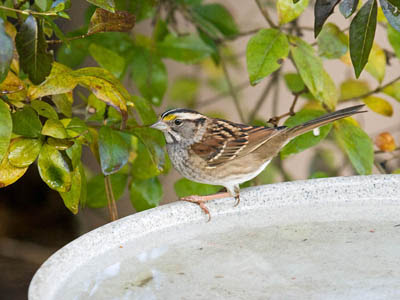 |
| White-throated Sparrow. Greg Gillson. |
These birds breed in Canada and northeastern United States. In winter they occur in the eastern and southern U.S.
White-throated Sparrows winter throughout Missouri.
These fairly large brown and gray sparrows have a striped head. The head striping can be gray and tan or black and white. The obvious white throat is bordered on the sides with throat stripes and contrasts strongly with the gray breast.
White-throated Sparrows eat smaller seeds such as white proso millet found in better mixed seed brands. They prefer to eat on the ground or platform feeders, but will also use hopper feeders.
White-breasted Nuthatch
Nuthatches are active birds that crawl around branches and even head-first down tree trunks!
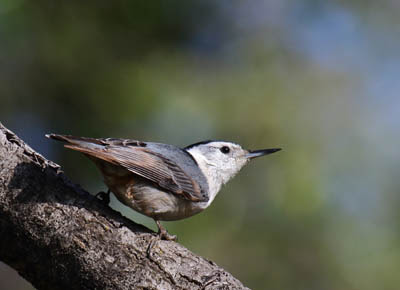 |
| White-breasted Nuthatch. Greg Gillson. |
These are widespread year-round birds across southern Canada and much of the United States. They avoid grasslands and deserts.
White-breasted Nuthatches are year-round residents throughout Missouri.
These are small chunk birds with large heads with long pointed bill and very short tails. These are gray above with black hind neck and crown. The face and under parts are white. They have a bit of rusty coloration on the flanks.
White-breasted Nuthatches eat black oil sunflower seeds from tube and hopper feeders and are fond of peanuts and suet, too.
Downy Woodpecker
This small woodpecker is widespread in North America and fairly common at bird feeders in winter.
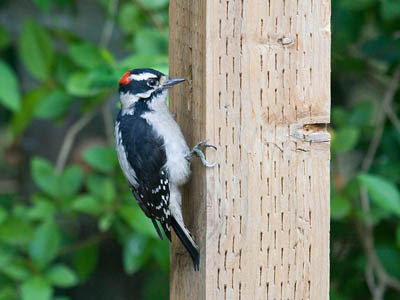 |
| Downy Woodpecker. Greg Gillson. |
Year-round residents from Alaska and across Canada south through the United States, but absent from the Desert Southwest.
Downy Woodpeckers are year-round residents throughout Missouri.
These are less than 7 inches long, bill tip to tail tip. They have a black and white striped head, white back, and black wings with white spots.
Downy Woodpeckers love suet from suet feeders. They also eat hulled sunflower seeds.
Northern Cardinal
These are well-known birds due to their bright red coloration, fairly large size, and perky crest.
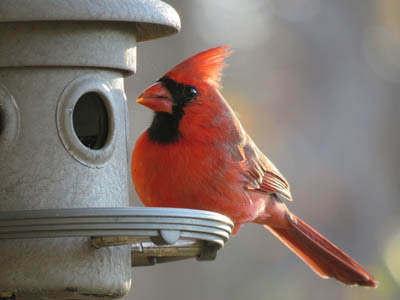 |
| Northern Cardinal. GeorgeB2 from Pixabay. |
These are year-round residents throughout the East and South.
Northern Cardinals are year-round residents throughout Missouri.
Larger than sparrows, but smaller than robins. Males are bright red, females brown. They have thick orange bills, black chin and throat, and obvious crests.
Northern Cardinals eat larger seeds, including sunflower seeds and safflower seeds from hopper and platform feeders, but often feed on the ground.
House Sparrow
These are common city birds in noisy messy flocks.
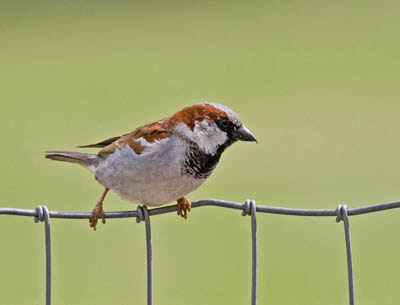 |
| House Sparrow. Greg Gillson. |
Found throughout much of Canada and the United States, wherever there are people and towns.
House Sparrows are year-round residents throughout Missouri.
Small squatty flat-headed sparrows. Females are rather brown and tan with a pale broad eyebrow, and plain breast without streaking. Males are more chestnut brown above with white wing bars, gray below, with gray crown and black chin, more extensive in summer.
House Sparrows eat a wide variety of small seeds and human food scraps from hopper and platform feeders, and also the ground.
Northern Flicker
These larger ant-eating woodpeckers may often be spotted feeding on the ground.
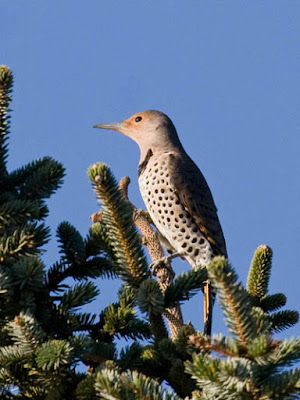 |
| Northern (Yellow-shafted) Flicker. Greg Gillson. |
In summer they range from Alaska and across Canada through most of the United States except the deserts. In winter they are found across the lower 48 states, including the deserts.
Northern Flickers are year-round residents throughout Missouri.
These are bigger birds than robins with long slightly curved bill and short pointed tail. Their backs are barred black and brown. The pink underparts are full of round black spots. A white rump shows when flying away. Birds in the East (Yellow-shafted) have yellow wing and tail feathers; those in the West (Red-shafted) have salmon-red wing and tail feathers.
Northern Flickers eat suet from suet feeders. They also like nuts and peanuts.
Setting up a winter bird feeding station in Missouri
To attract most of the birds that are displayed above, I would set up a hopper bird feeder with mixed bird seed. I would probably add in about 50% more black oil sunflower seed.
For instance, I would purchase my favorite mixed bird seed, Wagner’s Songbird Supreme. It’s already half sunflower seeds (whole and shelled types). Then purchase black oil sunflower seed and mix them half-and-half. That way it’s about 75% sunflowers and 15% white proso millet.
The sunflower seeds will especially appeal to the White-breasted Nuthatches, Black-capped Chickadees, American Goldfinches, Northern Cardinals, Tufted Titmouses, Blue Jays, Mourning Doves, and House Finches.
The white proso millet in the mixed seed will especially appeal to the House Sparrows, White-throated Sparrows, and Dark-eyed Juncos.
Next I would set up a suet feeder. I like the Nature’s Way upside-down suet feeder to slow down the blue jays, starlings, and blackbirds. That leaves more St. Alban’s Bay suet for the White-breasted Nuthatches, Downy Woodpeckers, Red-bellied Woodpeckers, Tufted Titmouses, and Black-capped Chickadees.
The above feeders and foods will then attract all the birds above. You’ll have a great time feeding birds this winter!
Also, I would recommend a bird bath with a heater to provide water for the birds through those longer frozen Missouri winters.
Wrapping Up
Birds in Missouri employ a variety of strategies to survive the colder temperatures and reduced food availability during winter:
Physiological Adaptations:
- Increased feather density: Grow thicker plumage to trap insulating air and retain body heat.
- Increased metabolism: Burn more energy to generate heat, requiring them to find more food.
- Behavioral changes: Reduce activity levels to conserve energy and spend more time resting in sheltered areas.
Food-finding Strategies:
- Shifting diets: Many birds switch from insects, which become scarce in winter, to berries, seeds, and nuts.
- Flocking: Join larger groups to improve foraging efficiency and share information about food sources.
- Visiting feeders: Take advantage of readily available food offered by birdwatchers.
- Seeking sheltered areas: Look for trees and shrubs with dense foliage or fallen leaves that harbor insects and provide protection from wind and snow.
Habitat Selection:
- Moving to warmer areas: Some birds, like many warblers and tanagers, migrate south to escape the harshest winter weather.
- Choosing protected habitats: Seek out woodlands, dense thickets, and areas near sources of water, which offer shelter and potential food sources.
- Using natural shelters: Utilize cavities in trees, rock crevices, and dense vegetation for protection from the elements.
Frequently Asked Questions
How do you identify a winter sparrow?
Identifying a winter sparrow can be tricky due to their similar appearances and streaky plumage. However, with some careful observation and key features in mind, you can narrow down your options and confidently identify these fascinating little birds.
Most winter sparrows are small, roughly the size of a House Sparrow or smaller, look for a rounded head, short neck, and plump body.
Many winter sparrows have streaked chests and backs, but the pattern and color can vary. Pay attention to the crown color, eye stripes, facial masks, and any distinctive markings.
Observe the pattern and color of the streaks, noting if they’re bold or faint, vertical or horizontal, and any central spots or bars. Check for wing bars, stripes, or other markings.
Lastly, consider the length and shape of the tail, and if it has any noticeable markings.
What types of sparrows are in Missouri in the winter?
- Song Sparrow: Heavily streaked chest with a central dark spot, bold stripes on the head, long tail.
- Savannah Sparrow: Yellowish eyebrow, finer streaks on chest, shorter tail than Song Sparrow.
- Field Sparrow: Pinkish bill, gray head, and faint streaks on chest.
- Chipping Sparrow: Unstreaked chestnut crown, faint gray streaks on chest, compact body.
- Fox Sparrow: Large size, bold rusty chest and head, long tail with white corners.
What birds migrate from Missouri for the winter?
Many birds migrate from Missouri for the winter, seeking warmer temperatures and abundant food sources further south. Here are some prominent examples:
Warblers:
- Yellow Warblers
- American Redstarts
- Ovenbirds
- Black-throated Blue Warblers
- Hooded Warblers
Tanagers:
- Scarlet Tanagers
- Summer Tanagers
- Western Tanagers
Other Songbirds:
- Orioles (Baltimore Orioles, Orchard Orioles)
- Yellow-billed Cuckoos
- Hummingbirds (Ruby-throated Hummingbirds)
- Vireos (White-eyed Vireos, Yellow-throated Vireos)
- Flycatchers (Great Crested Flycatchers, Eastern Wood-Pewees)
Related Articles:
The most common backyard birds in Missouri
My recommended bird feeder setup
Bird seeds that attract the most birds
Different kinds of bird feeders for different birds
Bird baths that birds actually use
Binoculars for beginning bird watchers
Bird watching books for beginners






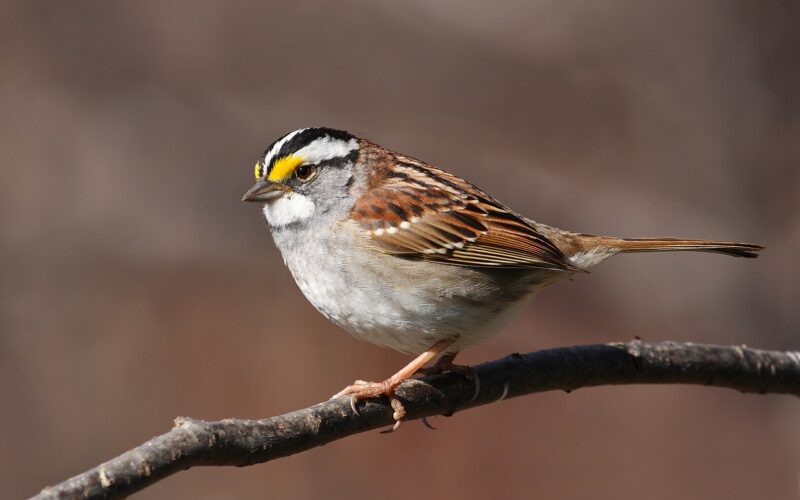





Thanks for the information about these birds that I fell in love with. Feeding everyday like they care. But I do. From the city to the suburbs with my new plant collection.
You are welcome!
Thank you for all the information you provided in this article. This is the first but not the last of your articles I will be reading. This information has helped me a lot with my winter bird feeding questions. I will be reading more of your articles and putting your advice into practice. Again, thank you. What I'm learning is invaluable to me.
I am so happy that you find this useful!
I have the usual suspects hanging around. I throw the sunflower seeds on the ground in my backyard woods. I have a 2×8 board on the corner of my fence. I screwed down some egg cartons on it and threw seed in that. Several takers but they really enjoy/prefer searching the ground. The woodpeckers are the best because they fly to the nearest tree and hide their seeds, too funny. Best thing about deciding to forego the bird feeders is no cleaning and squirrels gotta work just as much to find the seeds.
Sounds like you've figured out a solution for your yard. I have another article on throwing bird seed on the ground to feed them